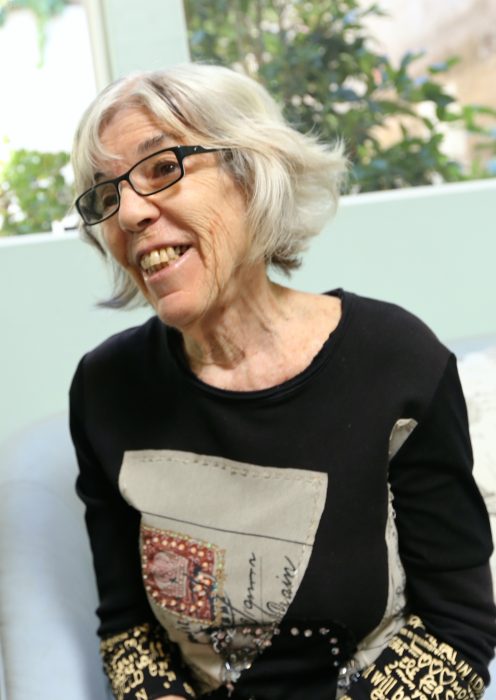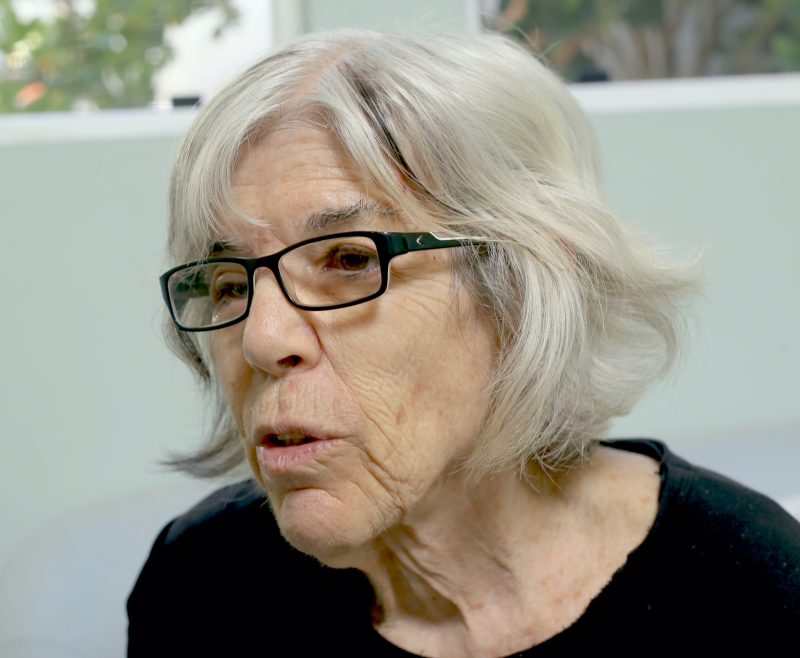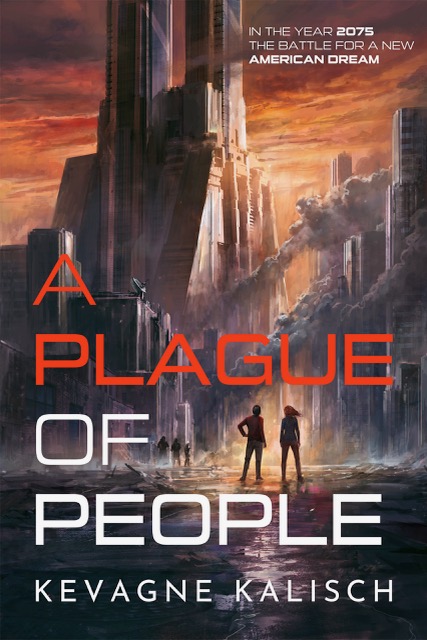New author and former drinker embracing alternative therapies to help others break the habit
Seated in the backroom of a café on Polk Street, Kevagne Kalisch leans against the wall and stares at a nearby painting of two clowns: one grinning, the other crying. Turning, she said she’s puzzling how to tell her own story: one of happiness and grief.
Kalisch, 78, struggled with alcoholism for many years. She quit in 2005 and is now certified to help others through mind-body healing and motivational enhancement techniques used to address trauma and addiction.

Her first attempt at recovery was in her 20s when she began attending Alcoholics Anonymous meetings. “I did the 12 steps and I was proud!” she said. She stopped drinking for two years, but there followed 30 years of drinking, taking painkillers like codeine, and an assortment of jobs: insurance salesperson, probation officer, food server, English teacher, social worker, and summer camp drama coach.
“As time went on, because of my addictions, I got all kinds of jobs according to the state of mind I was in,” she said, notwithstanding an undergraduate degree in theatre arts.
The best of those was at a community newspaper in Palos Verdes, where she wrote a “rags to riches” column about local residents and the owner taught her “how to prep the newspaper to meet the weekly deadlines.” But that lasted only a year or so.
Kalisch traveled the world, living in Sydney, Australia, for 17 years. Her partner was a retired scientist. Still drinking, she rationalized that it was only two glasses of wine a night. But her partner pointed out the goblet she drank from amounted to nearly an entire bottle and too many nights of drunkenness.
Her last drink
She decided to abstain for 30 days and see how she felt. But on the last day, she drank so much that she became ill, slipped, fell, and broke her ankle. She ended up in the emergency room of the nearby hospital. She said a voice inside her said “You’re done.” That was her last drink.
Quitting wasn’t easy. Through the internet, she discovered somatic therapy, which uses mind-body techniques to shift ingrained habits. There is growing evidence for these as a complementary treatment for substance abuse, according to Albert Wong, former professor of somatic therapy at John F. Kennedy University and currently an educator and trainer in the field.
Kalisch went on to get an online training certificate at Kiloby Inquiries. With other students, she has been practicing “somatic inquiry,” which involves observing all the body’s senses to get more in touch with feelings and beliefs related to addiction and trauma from childhood.

“I truly feel such joy when someone has a breakthrough about something that might have been haunting them from childhood,” she said.
She also found SMART Recovery, which offers online peer support through video storytelling and motivational enhancement tools. Her favorite is cost-benefit analysis. “What’s so interesting to me about it is someone can honestly look at the costs and the benefits they get out of their drinking,” she said, “and get more clarity and feel less shame about their behavior.
Early upheavals
Upheavals in Kalisch’s life began at the age of four when her parents divorced. Her mother remarried, and the family later moved to New Delhi, India, where her stepfather taught at a teachers’ college. Even though he rarely ever gave his approval, her stepfather did encourage her to continue her education at Goddard College in Plainfield, Vermont, which was renowned for its innovative approach to learning.
At Goddard, she tested her own creative thresholds and pursued theater arts, dance, music, and writing. She studied modern jazz dance with Mark Ryder, formerly with the Martha Graham Dance Company.
He became her mentor and friend.
“Even though I became a very good jazz dancer, I was addicted to amphetamines such as Dexedrine while I was studying with him,” she said. “It was like the whole thing from childhood played out again: self-defeating. I couldn’t allow myself to get so good at dancing that I could actually turn it into a career.”
In reminiscing about her days of insobriety, she talks about the 1980s when she worked on an assembly line at a plastic mop factory in Los Angeles.
“I liked jamming with the other folks on the line, lots of joking. One day I was called into the boss’s office and asked about my education level. I told the man that I had gone to college, and had an undergraduate degree,” she said.
“He told me that I had been disruptive, slowed down the assembly line with all my talking and given my level of education, I had options the other folks did not have. I needed to leave this job and understand the bigger picture.”
Stuck in menial jobs
It was a confrontation that made her realize she had opted for menial jobs because she could keep using, she wouldn’t be challenged.
Eventually, she taught herself bookkeeping. “That became the most practical way to keep food on the table and I’ve always enjoyed working with numbers,” she said.

She later worked as a drama coach at senior centers and started writing her memoir. She recently published her first novel, “A Plague of People,” a science fiction tale of political divisions in the United States. She credits her Australian partner, David Sheriff, who started the book but died of a brain hemorrhage in 2009.
“I had worked by his side as his editor, and there was so much I liked about his setting and characters. However, over a decade later, and with mixed feelings, I came to the conclusion that I had to rewrite the manuscript.
Another challenge for Kalisch has been her chronic leukemia, but one, like all others, that she addresses head-on. She walks one mile each day in her Upper Nob Hill neighborhood and is working with a master herbalist. She’s also employing meditation, breathwork, and somatic inquiry therapy.
And she’s planning to add one more certification to her counseling skillset, Internal Family Systems, so she can offer her services to the public.
“I feel I have a lot to offer people. I have gained so much wisdom during my last 19 years of sobriety,” she said. “It is so rewarding when I can help someone face any kind of trauma or addictive behavior.”






Kevagne Kalisch
Colin did a fabulous job with the photo shoot.
Tego
Great portrait of Kevagne.